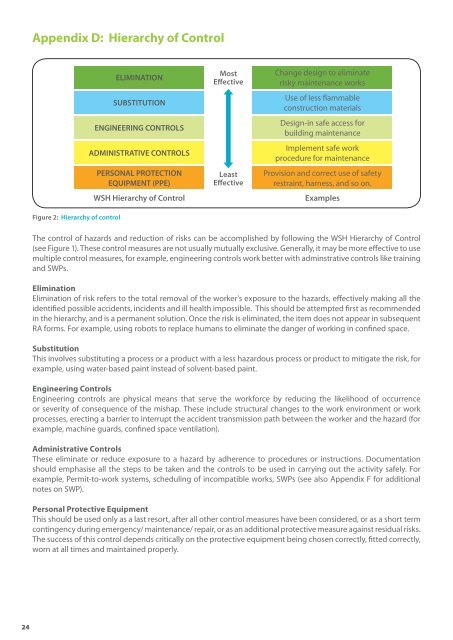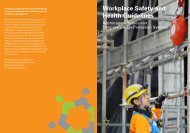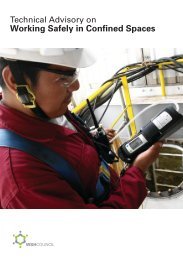Risk Management - Workplace Safety and Health Council
Risk Management - Workplace Safety and Health Council
Risk Management - Workplace Safety and Health Council
You also want an ePaper? Increase the reach of your titles
YUMPU automatically turns print PDFs into web optimized ePapers that Google loves.
Appendix D: Hierarchy of ControlFigure 2: Hierarchy of controlELIMINATIONSUBSTITUTIONENGINEERING CONTROLSADMINISTRATIVE CONTROLSPERSONAL PROTECTIONEQUIPMENT (PPE)WSH Hierarchy of ControlMostEffectiveLeastEffectiveChange design to eliminaterisky maintenance worksUse of less flammableconstruction materialsDesign-in safe access forbuilding maintenanceImplement safe workprocedure for maintenanceProvision <strong>and</strong> correct use of safetyrestraint, harness, <strong>and</strong> so on.ExamplesThe control of hazards <strong>and</strong> reduction of risks can be accomplished by following the WSH Hierarchy of Control(see Figure 1). These control measures are not usually mutually exclusive. Generally, it may be more effective to usemultiple control measures, for example, engineering controls work better with adminstrative controls like training<strong>and</strong> SWPs.EliminationElimination of risk refers to the total removal of the worker’s exposure to the hazards, effectively making all theidentified possible accidents, incidents <strong>and</strong> ill health impossible. This should be attempted first as recommendedin the hierarchy, <strong>and</strong> is a permanent solution. Once the risk is eliminated, the item does not appear in subsequentRA forms. For example, using robots to replace humans to eliminate the danger of working in confined space.SubstitutionThis involves substituting a process or a product with a less hazardous process or product to mitigate the risk, forexample, using water-based paint instead of solvent-based paint.Engineering ControlsEngineering controls are physical means that serve the workforce by reducing the likelihood of occurrenceor severity of consequence of the mishap. These include structural changes to the work environment or workprocesses, erecting a barrier to interrupt the accident transmission path between the worker <strong>and</strong> the hazard (forexample, machine guards, confined space ventilation).Administrative ControlsThese eliminate or reduce exposure to a hazard by adherence to procedures or instructions. Documentationshould emphasise all the steps to be taken <strong>and</strong> the controls to be used in carrying out the activity safely. Forexample, Permit-to-work systems, scheduling of incompatible works, SWPs (see also Appendix F for additionalnotes on SWP).Personal Protective EquipmentThis should be used only as a last resort, after all other control measures have been considered, or as a short termcontingency during emergency/ maintenance/ repair, or as an additional protective measure against residual risks.The success of this control depends critically on the protective equipment being chosen correctly, fitted correctly,worn at all times <strong>and</strong> maintained properly.24
















